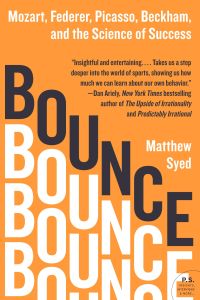Join getAbstract to access the summary!

Join getAbstract to access the summary!
Matthew Syed
Bounce
Mozart, Federer, Picasso, Beckham, and the Science of Success
Harper, 2010
What's inside?
Why lots and lots of correct practice really does make perfect, and why talent may not matter at all
Recommendation
A United Kingdom table tennis champion, Matthew Syed recognizes that he succeeded not because of innate talent, but rather due to the special circumstances of his youth. He was able to learn from expert, dedicated teachers and to practice all the time. Syed knows he was fortunate and, to his credit, he worked hard to become as good as he could be. He discusses the science that demonstrates the validity of the adage, “Practice makes perfect.” He explodes the “talent myth” by presenting scientific evidence that people who practice with enough diligence, patience and focused intensity can become great, regardless of the presence or absence of supposedly inborn ability. Syed covers numerous other fascinating topics, including racial stereotypes, the “placebo effect” and baseball players’ “good luck” rituals. Syed’s well-researched, enlightening book is a hymn to the power and efficacy of practice, dedication, determination and hard work.
Summary
About the Author
Matthew Syed, a BBC commentator and The Times columnist, has won numerous British journalism awards. In table tennis, he is a two-time Olympian and a three-time Commonwealth champion.





















Comment on this summary